A new facility that has cubicle space for 178 cows, a 16-unit double-up parlour, a handling unit and a straw-bedded maternity wing is up and running at the Greenmount Campus, Co Antrim.
The objectives behind building the new unit were to provide a dairy facility that could meet student education training needs and demonstrate new technologies in dairy shed farming, such as energy efficiency and reducing greenhouse gases.
Ian McCluggage, head of dairy advisers at Greenmount, said that the milk production system in Northern Ireland simply must get some grazed grass into cows and at least 50% of the milk produced must come from forage.
The production system targets for the Greenmount ‘Future’ herd are to produce a profit in the top 15% of NI benchmarking and a milk yield between 8,000 and 8,500 litres per cow with 4,000 litres from forage or a total lifetime performance of 40,000 litres. The plan is to do this using 2.1t of meal per cow, grazed grass and forages indoors. Before we went into the new shed, Ian McCluggage said: “I don’t want to see the new dairy unit replicated at farm level but there are aspects of the new building that some farmers might incorporate into a new structure.”
The Greenmount unit cost £2.5m (€3m) to construct but this includes a reception area, viewing gallery, lift and a high-spec exterior finish. The design team suggest that you could replicate the unit without the site-specific costs met at Greenmount and less high-spec finish and facilities for approximately £1.5m (£8,400/cow or €10,140/cow).
The borrowings for such a large-scale commercial investment at farm level in cow housing and handling would take a couple of farm generations to pay back. Ian also explained that not everything installed had worked and, only last week, the hot water heating system was being replaced as it wasn’t heating the water enough.
The main sheds are two adjoining portal frame structures with a total footprint of 4,600m2. The first shed is the cubicle building, which is 67m x 31m with an eave height of 5m and a roof slope of 18o. The cubicle building contains 178 cubicles in four sections, a feed passage, four cow movement passageways and eight water troughs. The second shed holds the 16-unit double-up milking parlour and this building is 67m x 35m. This building also contains the collecting yard, handling facilities, bull pen and straw/sand-bedded maternity area. At the front are offices, changing rooms, viewing galleries, etc.
The cubicle dimensions for large Holstein-Friesian cows are based on a range of international standards. The cubicle length is 2.85m (9.3ft) with the brisket board 5ft from the back of the cubicle. The cubicle width is 1.15m (3.8ft) and the kerb height 0.15m.
The Greenmount staff say Kraiburg KEW Plus mattresses were chosen as they have comfort and shock absorption from three functional layers that:
Are independently performance tested.Have a 10-year guarantee.Had educational institute discounts. The Greenmount design team suggests that cubicles and mattresses have been specified to provide a sufficiently comfortable environment to encourage cows to lie in the cubicle for between 12 and 14 hours per day. The cubicle division has been designed to allow cows to exhibit a natural lying down and rising behaviour (Kingshay high neck rail).
You immediately notice when stepping into the shed that it has a lot of light and air. While both portal sheds are side by side, there is air coming in from both sides of the cubicle shed because the roof has been raised 1.3m above the adjoining milking parlour roof.
So, at one side, you have an air inlet screened with 25mm wire mesh bird proofing and an extended gutter to prevent rain coming in. The other side of the cubicle shed (the outside wall) has no wall but has a Galebreaker material that is computer controlled. This is a 10% permeable, PVC-coated polyester curtain material, which opens from the top down.
The outlet ridge in the centre of the building is 207mm and the ridge outlet is baffled using a Galebreaker light ridge.
The centre ridge also functions as a natural light source and the baffle prevents bird entry and rainfall through the ridge opening. The specification suggests 15% of the roof area comprises ‘see through’ light sheets. There are also 16 lights fitted, with 400W high-pressure sodium bulbs.
The front standing area where the cows eat is a hard rubber grooved area, while the back standing passage where the cows stand off the cubicles is concrete grooved.
The intention of the grooving is to keep cows’ hooves out of wet areas, provide a grip and reduce ammonia emissions. Farmers asked why both passages are not all rubber and the answer is to prevent cows’ hooves getting too soft.
At the open day, Greenmount advisers explained that ammonia is produced when urine and muck mix. The intention is, if you can allow the urine into the grooves or channels and then operate regular scraping into covered collection channels, you can reduce ammonia emissions by over 20%. There are 4m (very wide) passages either side of the feed face with a 3m passage in between cubicles.
The maternity wing has 12 calving pens which are each 4.0m x 4.0m and three straw-bedded calving pens that are 8m x 9.5m for cows near calving, post calving and under treatment. There is a passage to all pens, so one person can move cows from the pens to the parlour.
The parlour is built so students can practise preparation and routine and it has a 2.4m wide pit. Each cow space has feed managers with dual feed hoppers, dump line and buckets. There is auto id in each stall, electronic milk meters and cluster removers.
When cows leave the parlour, there is walk-over weighing, automatic hoof washer and footbath, three-way drafting, a single head to tail crush or a 16-cow herringbone crush.
In the collecting yard, there is an up and over backing gate, a pre-wetting sprinkler system and rubber flooring to prevent lameness due to sharp turning. There is a high flow rate plate cooler system, a 13,000-litre bulk tank and a variable speed pump. Near the parlour exit is the bull pen and this has a feeding and lying area that is 2m by 2.9m, an exercise area 2.9m x 5.8m, a cow service crate and circular forcing gates to ensure operator safety when feeding, cleaning or moving the bull.
Environmental measures
Herd manager Michael Graham showed me the measurements that are going on behind the scenes to measure environmental best practice with new technologies.
All rainwater is collected from the roof and recycled. It is passed through a UV light and used for washing down and the plate cooler. The main collector pipe is foil-insulated to prevent dripping onto cubicles if there was a temperature change from the outside.
All of the individual electronic parts are individually wired and metered so exactly how much each component is using can be measured.
All water inlets are metered so the amount of water that is used for washing, drinking and by various machines can be monitored.
On the feed face, there is a strip of Epoxy resin painted onto the concrete to encourage high dry matter intakes. The next rail on both sides of the feed face is a single rail which maximises intake rather than individual lock-up barriers.Cubicles are open-fronted onto feed passage.House temperature is set at 7oC.No troughs for diet feeding.The new dairy unit is state-of-the-art and comfortable for man and beast. It will be interesting to monitor indoor energy usage, milk production and fertility. Greenmount students must be disappointed when they go back home to more simplistic, practical and mundane set-ups. Greenmount justifies the new investment for training purposes. Staff agree that spending this amount of money on a cow shed and milking parlour at a commercial level before you buy a cow, reseed, fertilise a field, pay tax and living expenses or pay labour to help you manage 180 cows, is not on. The annual repayment for a £1.5m investment would be over £150,000 per year for 15 years.
A new facility that has cubicle space for 178 cows, a 16-unit double-up parlour, a handling unit and a straw-bedded maternity wing is up and running at the Greenmount Campus, Co Antrim.
The objectives behind building the new unit were to provide a dairy facility that could meet student education training needs and demonstrate new technologies in dairy shed farming, such as energy efficiency and reducing greenhouse gases.
Ian McCluggage, head of dairy advisers at Greenmount, said that the milk production system in Northern Ireland simply must get some grazed grass into cows and at least 50% of the milk produced must come from forage.
The production system targets for the Greenmount ‘Future’ herd are to produce a profit in the top 15% of NI benchmarking and a milk yield between 8,000 and 8,500 litres per cow with 4,000 litres from forage or a total lifetime performance of 40,000 litres. The plan is to do this using 2.1t of meal per cow, grazed grass and forages indoors. Before we went into the new shed, Ian McCluggage said: “I don’t want to see the new dairy unit replicated at farm level but there are aspects of the new building that some farmers might incorporate into a new structure.”
The Greenmount unit cost £2.5m (€3m) to construct but this includes a reception area, viewing gallery, lift and a high-spec exterior finish. The design team suggest that you could replicate the unit without the site-specific costs met at Greenmount and less high-spec finish and facilities for approximately £1.5m (£8,400/cow or €10,140/cow).
The borrowings for such a large-scale commercial investment at farm level in cow housing and handling would take a couple of farm generations to pay back. Ian also explained that not everything installed had worked and, only last week, the hot water heating system was being replaced as it wasn’t heating the water enough.
The main sheds are two adjoining portal frame structures with a total footprint of 4,600m2. The first shed is the cubicle building, which is 67m x 31m with an eave height of 5m and a roof slope of 18o. The cubicle building contains 178 cubicles in four sections, a feed passage, four cow movement passageways and eight water troughs. The second shed holds the 16-unit double-up milking parlour and this building is 67m x 35m. This building also contains the collecting yard, handling facilities, bull pen and straw/sand-bedded maternity area. At the front are offices, changing rooms, viewing galleries, etc.
The cubicle dimensions for large Holstein-Friesian cows are based on a range of international standards. The cubicle length is 2.85m (9.3ft) with the brisket board 5ft from the back of the cubicle. The cubicle width is 1.15m (3.8ft) and the kerb height 0.15m.
The Greenmount staff say Kraiburg KEW Plus mattresses were chosen as they have comfort and shock absorption from three functional layers that:
Are independently performance tested.Have a 10-year guarantee.Had educational institute discounts. The Greenmount design team suggests that cubicles and mattresses have been specified to provide a sufficiently comfortable environment to encourage cows to lie in the cubicle for between 12 and 14 hours per day. The cubicle division has been designed to allow cows to exhibit a natural lying down and rising behaviour (Kingshay high neck rail).
You immediately notice when stepping into the shed that it has a lot of light and air. While both portal sheds are side by side, there is air coming in from both sides of the cubicle shed because the roof has been raised 1.3m above the adjoining milking parlour roof.
So, at one side, you have an air inlet screened with 25mm wire mesh bird proofing and an extended gutter to prevent rain coming in. The other side of the cubicle shed (the outside wall) has no wall but has a Galebreaker material that is computer controlled. This is a 10% permeable, PVC-coated polyester curtain material, which opens from the top down.
The outlet ridge in the centre of the building is 207mm and the ridge outlet is baffled using a Galebreaker light ridge.
The centre ridge also functions as a natural light source and the baffle prevents bird entry and rainfall through the ridge opening. The specification suggests 15% of the roof area comprises ‘see through’ light sheets. There are also 16 lights fitted, with 400W high-pressure sodium bulbs.
The front standing area where the cows eat is a hard rubber grooved area, while the back standing passage where the cows stand off the cubicles is concrete grooved.
The intention of the grooving is to keep cows’ hooves out of wet areas, provide a grip and reduce ammonia emissions. Farmers asked why both passages are not all rubber and the answer is to prevent cows’ hooves getting too soft.
At the open day, Greenmount advisers explained that ammonia is produced when urine and muck mix. The intention is, if you can allow the urine into the grooves or channels and then operate regular scraping into covered collection channels, you can reduce ammonia emissions by over 20%. There are 4m (very wide) passages either side of the feed face with a 3m passage in between cubicles.
The maternity wing has 12 calving pens which are each 4.0m x 4.0m and three straw-bedded calving pens that are 8m x 9.5m for cows near calving, post calving and under treatment. There is a passage to all pens, so one person can move cows from the pens to the parlour.
The parlour is built so students can practise preparation and routine and it has a 2.4m wide pit. Each cow space has feed managers with dual feed hoppers, dump line and buckets. There is auto id in each stall, electronic milk meters and cluster removers.
When cows leave the parlour, there is walk-over weighing, automatic hoof washer and footbath, three-way drafting, a single head to tail crush or a 16-cow herringbone crush.
In the collecting yard, there is an up and over backing gate, a pre-wetting sprinkler system and rubber flooring to prevent lameness due to sharp turning. There is a high flow rate plate cooler system, a 13,000-litre bulk tank and a variable speed pump. Near the parlour exit is the bull pen and this has a feeding and lying area that is 2m by 2.9m, an exercise area 2.9m x 5.8m, a cow service crate and circular forcing gates to ensure operator safety when feeding, cleaning or moving the bull.
Environmental measures
Herd manager Michael Graham showed me the measurements that are going on behind the scenes to measure environmental best practice with new technologies.
All rainwater is collected from the roof and recycled. It is passed through a UV light and used for washing down and the plate cooler. The main collector pipe is foil-insulated to prevent dripping onto cubicles if there was a temperature change from the outside.
All of the individual electronic parts are individually wired and metered so exactly how much each component is using can be measured.
All water inlets are metered so the amount of water that is used for washing, drinking and by various machines can be monitored.
On the feed face, there is a strip of Epoxy resin painted onto the concrete to encourage high dry matter intakes. The next rail on both sides of the feed face is a single rail which maximises intake rather than individual lock-up barriers.Cubicles are open-fronted onto feed passage.House temperature is set at 7oC.No troughs for diet feeding.The new dairy unit is state-of-the-art and comfortable for man and beast. It will be interesting to monitor indoor energy usage, milk production and fertility. Greenmount students must be disappointed when they go back home to more simplistic, practical and mundane set-ups. Greenmount justifies the new investment for training purposes. Staff agree that spending this amount of money on a cow shed and milking parlour at a commercial level before you buy a cow, reseed, fertilise a field, pay tax and living expenses or pay labour to help you manage 180 cows, is not on. The annual repayment for a £1.5m investment would be over £150,000 per year for 15 years.



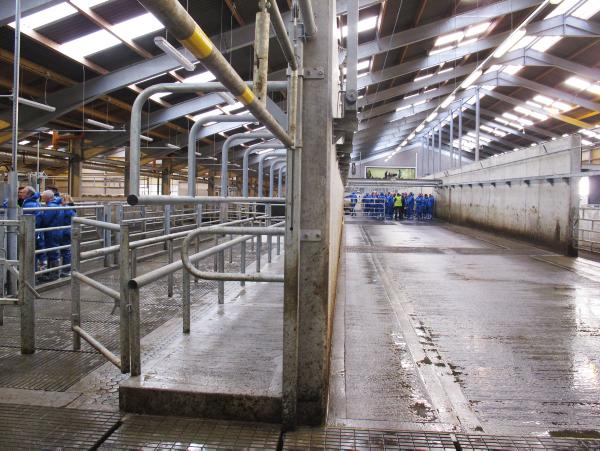
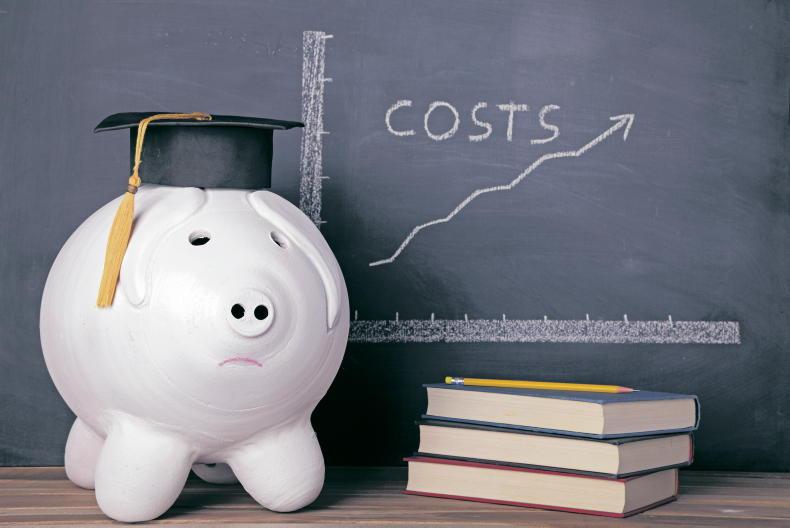
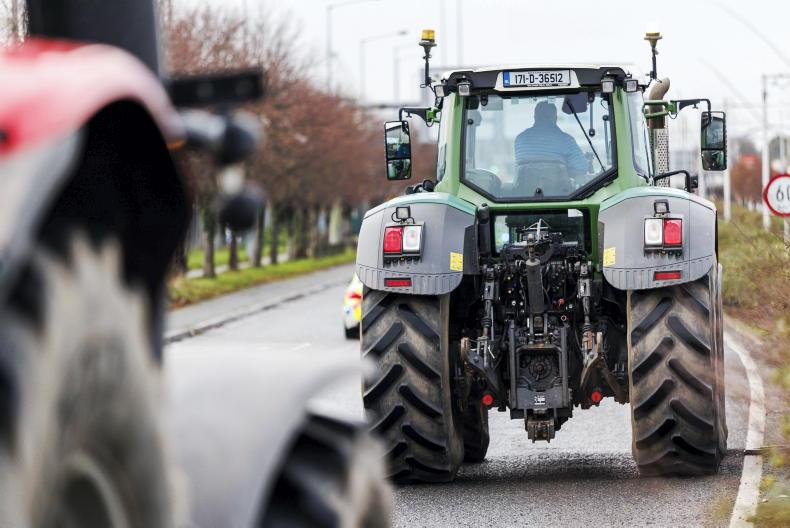
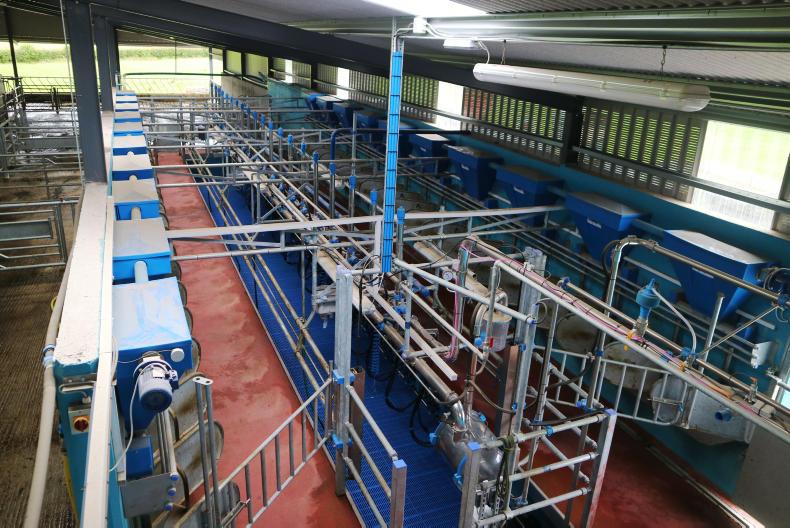
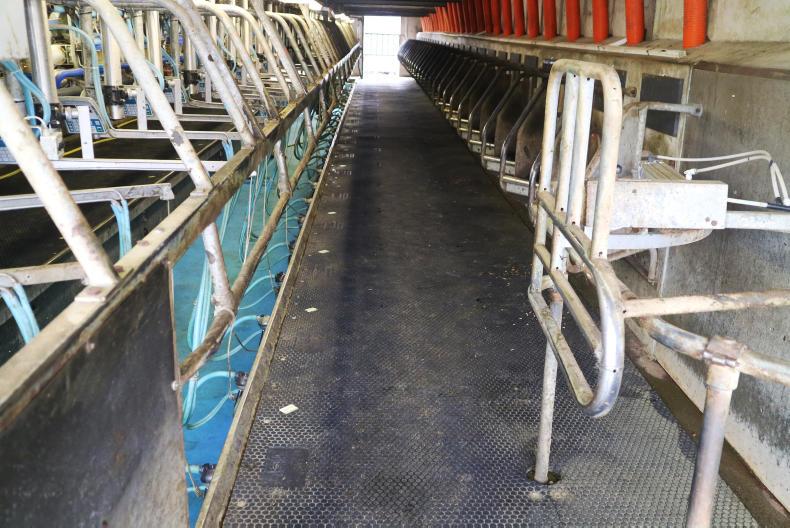
SHARING OPTIONS